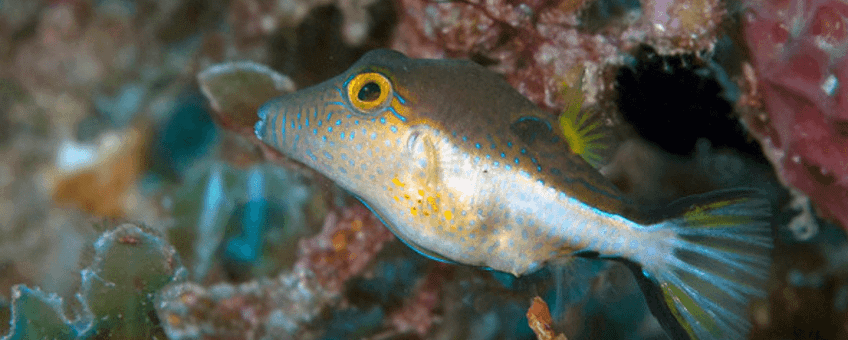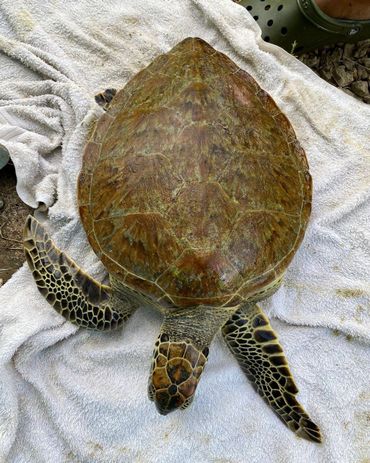
What’s happening to the pufferfish in the Caribbean?
Dutch Caribbean Nature Alliance (DCNA)The sharp-nose puffer (Canthigaster rostrata) is a small species of pufferfish found throughout the Caribbean. It is relatively small, growing up to only seven centimetres in length, and is easily recognizable by its beaked snout and black and white stripes on its body. This fish is often found in shallow waters around coral reefs, where it feeds on algae and small invertebrates. While it may seem harmless due to its small size, the sharp-nose puffer is actually quite toxic. Like all pufferfish, it contains a potent toxin known as tetrodotoxin, which is found in its skin, liver, and other organs.

Bonaire and Curacao
In recent weeks, Bonaire and Curacao have seen a large number of these pufferfish washing ashore. Although the root cause is still unknown, it is likely linked to the population explosion seen on the reef the months before. This parallels to the 2017 mass mortality event that occurred along the Caribbean coast of Costa Rica.
Costa Rica
After this incident in Costa Rica, individual pufferfish were collected and studied to identify the cause of this mass die off. It was thought this episode could be linked to similar events in other Caribbean locations and may be associated with changes in sea temperature or resource exhaustion during their recruitment period. In the end, no single cause could be identified, but this study highlighted the need to document and monitor indicators of changes in the ocean, and scientifically document mass mortality events.
Impacts
 The sight of hundreds of these tiny pufferfish washing ashore on Bonaire and Curacao immediately raised concern on the islands. In addition to being alarming for residents and tourists, these sick pufferfish can also have a significant impact on animals who may be scavenging for food, as these fish can be quite toxic. Green sea turtles are opportunistic feeders, meaning they will quickly snack on dead fish they find along the reef. Sea Turtle Conservation Bonaire (STCB) has already had several reports of sick green turtles since the start of this incident. STCB has had eight turtles in rehab so far and has conducted necropsies on two juvenile green turtles. During the necropsy, STCB discovered 37 pufferfish in one turtle’s stomach, enough to be a lethal snack for a young green turtle.
The sight of hundreds of these tiny pufferfish washing ashore on Bonaire and Curacao immediately raised concern on the islands. In addition to being alarming for residents and tourists, these sick pufferfish can also have a significant impact on animals who may be scavenging for food, as these fish can be quite toxic. Green sea turtles are opportunistic feeders, meaning they will quickly snack on dead fish they find along the reef. Sea Turtle Conservation Bonaire (STCB) has already had several reports of sick green turtles since the start of this incident. STCB has had eight turtles in rehab so far and has conducted necropsies on two juvenile green turtles. During the necropsy, STCB discovered 37 pufferfish in one turtle’s stomach, enough to be a lethal snack for a young green turtle.
Implications
Although there is still no clear answer as to what has caused this mass die off, it is likely linked to the population boom seen in the months before. Extreme competition for resources could leave large numbers of their population undernourished or vulnerable to disease. It does not seem that whatever caused this mass die off is affecting other species of fish, but it is important to stay vigilant and report any unusual sightings to the local park authorities.
DCNA
The Dutch Caribbean Nature Alliance (DCNA) supports science communication and outreach in the Dutch Caribbean region by making nature related scientific information more widely available through amongst others the Dutch Caribbean Biodiversity Database, DCNA’s news platform BioNews and through the press. This article is part of a series of articles on ‘Invasive Alien Species in the Dutch Caribbean”. This article contains the results from several scientific studies but the studies themselves are not DCNA studies. No rights can be derived from the content. DCNA is not liable for the content and the in(direct) impacts resulting from publishing this article.
Text: Dutch Caribbean Nature Alliance (DCNA)
Photos: Rudy van Geldere; Sea Turtle Conservation Bonaire (STCB)
